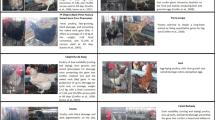Abstract
IN mammals and in Drosophila, it has been found that F 1 incrosses are less variable than their parent inbred lines in respect of a number of characters1. In chickens, Shultz2 has reported an average reduction of environmental variance in egg shape, November egg-weight, and shank-length, in eight F 1's between lines with relatively low degrees of inbreeding (F between 38 and 58 per cent).
Similar content being viewed by others
References
See, inter alia, Claringbold, P. J., and Biggers, J. D., J. Endocrin., 12, 9 (1955). Lerner, I. M., “Genetic Homeostasis” (Oliver and Boyd, Edinburgh, 1954). Livesay, E. A., Genetics, 15, 17 (1930). Maynard Smith, J., and Maynard Smith, S., J. Genetics, 52, 152 (1954). McLaren, A., and Michie, D., J. Genetics, 54, 440 (1956). Robertson, F. W., and Reeve, E. C. R., Z. indukt. Abstamm.- u. Vererb.-lehre, 86, 424 (1955).
Shultz, F. T., Biometrics, 9, 336 (1953).
Yoon, C. H., Genetics, 40, 297 (1955).
Author information
Authors and Affiliations
Rights and permissions
About this article
Cite this article
CLOUGH, M., COCK, A. Variability of Inbred and Incross Chickens. Nature 179, 1030–1031 (1957). https://doi.org/10.1038/1791030a0
Issue Date:
DOI: https://doi.org/10.1038/1791030a0
- Springer Nature Limited
This article is cited by
-
Choice of Animals and Sensitivity of Experiments
Nature (1962)
-
Variance Control in the Animal House
Nature (1958)




